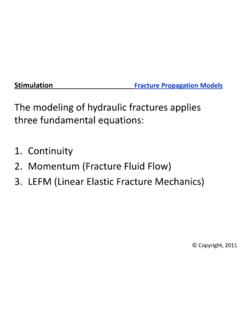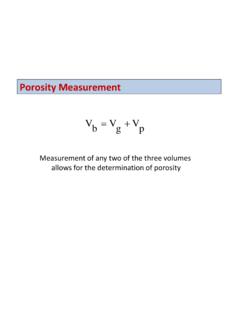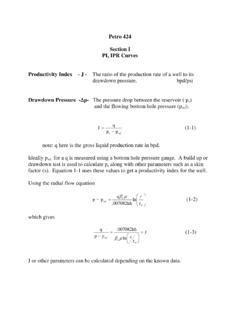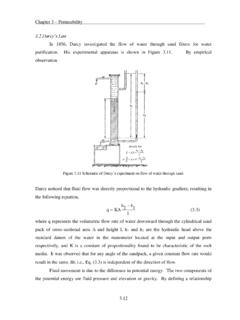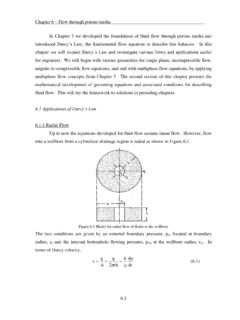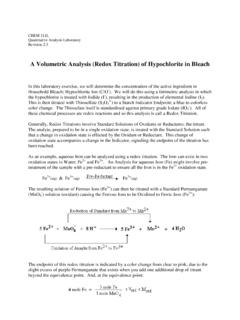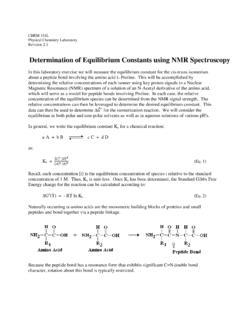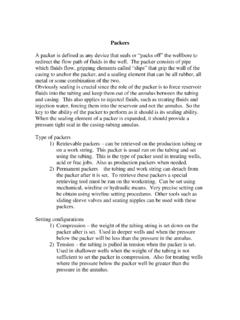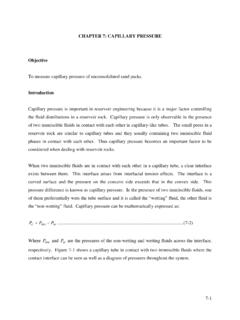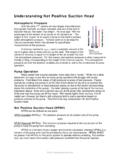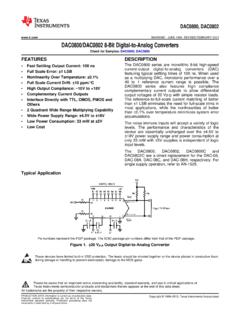Transcription of V S Vp V S V S Vp - New Mexico Tech: New Mexico …
1 Chapter 4 Saturation Saturations The pore spaces in underground rocks that form oil and gas reservoirs are always completely saturated with fluid. In the pores of the reservoir, there is never an occasion or location where nothing exists ( , truly "void space ). The pores are completely filled with some combination of the following fluids: (1) oil and its associated impurities in the liquid phase; (2) natural gas and its associated impurities in the vapor phase; (3) water--either connate water or water that flowed or was injected into the reservoir. During deposition, when sediments were being deposited (usually in an aqueous environment), the pores were completely saturated with water ( , water saturation was 100% of the pore space).
2 Later, during deep burial, compaction, and partial cementation, the water may have changed in composition, but the saturation remained 100% unless hydrocarbons entered the pores and forced the water out. If the water-saturated pores happen to be near an active hydrocarbon source rock, such as organic-rich shale, and the pores are in pressure communication with the source rock, hydrocarbons can enter the pores and occupy space. Normally, the hydrocarbons are less dense than the water, and the resulting buoyant force causes the oil or gas to migrate through the porous, permeable rock until it escapes at the surface or is stopped by an impermeable layer that forms a seal.
3 If there is sufficient closure the hydrocarbon accumulation may result in a commercial oil or gas reservoir. In the pores of oil or gas reservoirs, there always remains some water that was there before the hydrocarbon entrapment. At any time during the life of an oil or gas reservoir, the following relationship must hold true. S S S ( ). o w g where: oil volume V. S o o pore volume V. p water volume Vw S ( ). w pore volume V. p gas volume V. g S . g pore volume V. p Chapter 4 Saturation It is common for oil or gas saturation to be zero, but water saturation is always greater than zero. Saturation is a direct measure of the fluid content of the porous rock.
4 It therefore directly influences the hydrocarbon storage capacity of the reservoir. Other uses are the identification of gas/oil or oil/water contacts by changes of residual saturation with depth, and indirectly it is used as a correlation variable to estimate the productivity of reservoir rocks. Saturation distribution in reservoirs During hydrocarbon accumulation in the reservoir, water saturation can be reduced to some small value, typically 5-40%, after which no more water can escape from the pores. This occurs when water saturation becomes immobile, at the irreducible water saturation. Petroleum literature contains several symbols for water saturation; Swi, Swc, Swir.
5 Care must be taken to ensure correct interpretation of the symbol. The following definitions should help. 1) Swir -irreducible water saturation, below which water cannot flow. 2) Swc -connate water saturation existing on discovery of the reservoir. It may or may not be irreducible. Be careful! 3) Swi -may mean irreducible, connate, or interstitial, which means saturation among the interstices, or pores. Interstitial may or may not signify irreducible. It may be the value on discovery of the reservoir, or the value at any time thereafter. S wi may also mean initial or original, which truly means the water saturation on discovery, but it may or may not be irreducible.
6 Density differences between gas and oil as well as between oil and water result in normal reservoir situations in which oil floats on water. If there is a free gas phase, the gas floats on the oil. Keep in mind that there will be some water saturation (at least the irreducible water saturation) throughout the reservoir, even in the pores at the very top. Figure shows a typical cross section of a reservoir where all three fluid phases are at mobile saturations. If a container were filled with oil, water, and gas with no porous medium in the container (porosity = 100%), the fluid interfaces would be distinct and fluid saturations would be: gas cap Sg = 100%.
7 Chapter 4 Saturation oil zone - So = 100%;. aquifer, water zone Sw = 100%. Figure Cross section of reservoir showing vertical segregation of fluids However, in actual reservoirs composed of porous rock, the fluid interfaces are not so distinct. Not only does water exist throughout the oil and gas zones at a saturation of at least irreducible water saturation, but the fluid contacts are generally spread over a distance of a few feet to tens of feet, depending on the density difference between the fluids and the permeability of the rock. Figure shows the spreading of fluid contacts and the normal distribution of fluids in a reservoir.
8 Figure Normal initial fluid distribution in a reservoir of uniform permeability and static equilibrium Chapter 4 Saturation In Figure , note the following important points: (1) OWC at 4245 ft.; (2) oil-water transition zone, to 4245 ft.; (3) GOC at ft.; (4) gas-oil transition zone, to ft.; (5) thickness of oil-water transition zone, ft; (6) thickness of gas-oil transition zone, ft; (7) irreducible water saturation, 20%; (8) free water level at 4248 ft. and the free oil level at 4234 ft. (the levels at which the OWC and GOC would occur in the wellbore in the absence of a porous medium, or in the reservoir if it were an open container with 100% porosity).
9 The spreading of transition zones is a microscopic phenomenon which will be discussed more in Chapter 5. Figure is a close-up of the saturation distribution across the OWC and through the oil-water transition zone. Figure Microscopic cross section of OWC and transition zone Factors Affecting Fluid Saturations A common method of obtaining fluid saturations is from measurements taken on core samples. Unfortunately, the fluid content in the core is altered by two processes: 1. the flushing of mud and mud filtrate into the adjacent formation, and 2. the release of confining pressure as the core is pulled to surface. Chapter 4 Saturation Figure illustrates on a microscopic level the invasion process of a water-based mud into an oil-bearing formation.
10 The top diagram is prior to being penetrated by the bit, therefore the saturations present are the connate water and oil. The middle diagram is after the bit has penetrated the formation and fluid invasion has flushed the original reservoir fluids. Note the increase in water saturation during this time. The final diagram shows the gas expansion as the core is brought to the surface. Figure Saturations in Characteristic sand during coring and recovery [CoreLab, 1983]. Chapter 4 Saturation An example of saturation changes occurring in the core from insitu to surface conditions is shown in Figure Note the significant decrease in oil saturation due to the invasion process.
